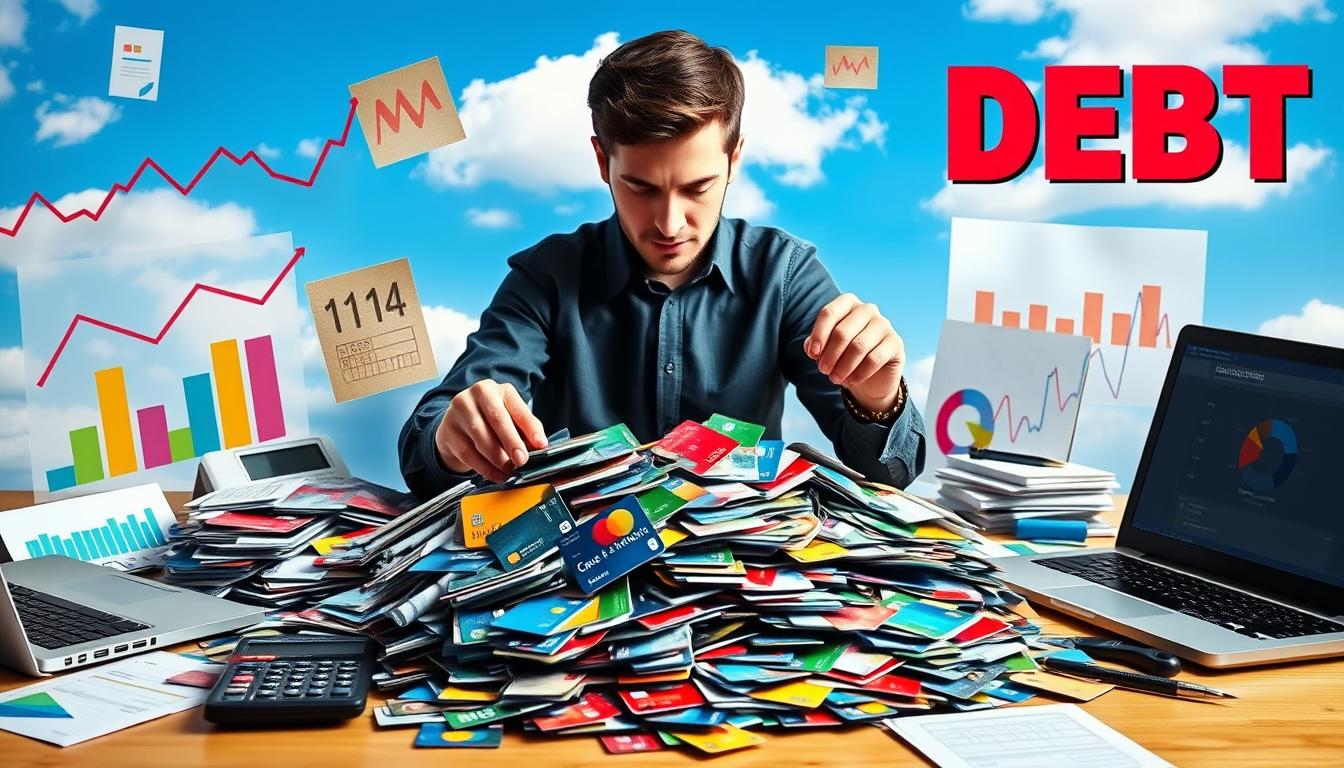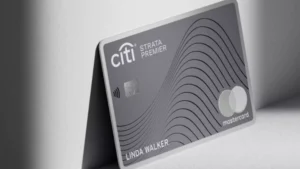Ever felt like your credit card debt is a money vacuum? It seems to take all your money. As a finance expert, I’ve seen many struggle with high interest and endless payments. Finding ways to pay off credit card debt is key to a better financial future.
High APRs make paying off debt seem impossible. But, there are smart ways to tackle it. Using strategies like the avalanche or snowball method can save you a lot of money. They also give you the motivation to keep going.
Creating a budget is the first step to beating credit card debt. Using tools and apps helps you see where your money goes. This makes paying off debt clearer and more achievable. By cutting down on unnecessary spending, you can put more money towards your debt.
Also, talking to credit card companies and using balance transfer offers can help. These strategies can lower the interest you pay over time. Imagine being debt-free and keeping your finances in check.
But, where do you start, and what should you avoid? Let’s dive deeper into these strategies. We’ll make paying off credit card debt a real possibility.
Understanding Your Credit Card Debt
Getting a handle on your credit card debt can feel like a big task. We’ll simplify it to help you manage and pay it off. Knowing what credit card debt is, how interest rates work, and the trap of minimum payments will help you pay off your debt faster.
What Constitutes Credit Card Debt?
Credit card debt is the money you owe to credit card companies. It’s not just for what you bought. It also includes the interest on your balance. This debt can grow fast because of extra charges and interest. So, it’s important to watch your spending and balances closely.
The Impact of Annual Percentage Rates (APRs)
The APR on your credit card is very important. It shows how much extra you’ll pay beyond what you borrowed. APRs vary but are usually around 16.3%. This rate affects how fast your debt grows if you don’t pay it off.
How Minimum Payments Extend Debt Duration
Paying the minimum each month keeps you in good standing. But it doesn’t lower your balance much. This approach might seem good at first but can make your debt last longer and cost more in interest. It’s key to understand this to break free from credit card debt.
By really getting these points—credit card debt, APR, and minimum payments—you can tackle your financial situation better. With the right knowledge, you can beat credit card debt.
Creating a Budget to Control Spending
Managing money starts with a key step: making a financial plan with a budget. It’s important to understand and change how we spend money. This helps with paying off debt and keeping our finances healthy.
Identifying Overspending Patterns
The first step is to look at where your money goes. Many of us don’t see how small things add up. For example, a $45 lunch might seem small, but it can add up over time.
By looking at these patterns, we can find places to cut back. This is where we can save money.
Allocating Funds Towards Debt Repayment
After finding ways to save, we need to use that money to pay off debt. With an average credit card balance of over $6,500 and an APR of about 23%, it’s important to act smart. Paying an extra 5-10% of your budget towards debt can save a lot of money in the long run.
Tools and Apps to Assist Budgeting
Today, there are many tools and apps to help with budgeting. Whether it’s a complex software or a simple spreadsheet, these tools help track spending. Apps like Mint or YNAB give you real-time updates and advice to improve your budget.
Using these strategies is more than just saving money. It’s about improving your financial health. By following a detailed budget, focusing on debt, and using modern tools, we can achieve financial freedom.
Strategies to Reduce Your Credit Card Balance
Managing credit card debt is key to staying financially healthy. I’ll share methods that have helped many, including myself, reduce credit card balances efficiently.
Paying More Than the Minimum Monthly Payment
Many think paying the minimum is enough to cut down debt. But, it usually takes longer because most of the payment goes to interest. By paying more than the minimum, we can pay off the debt faster and save on interest. This not only reduces your balance but also boosts your credit score.
Consolidation of Multiple Credit Card Balances
Debt consolidation is a smart way to handle multiple debts. It combines several high-interest balances into one with a lower interest rate. This makes payments simpler and can cut down interest costs a lot. For instance, merging different credit card debts into one loan can lead to a single payment that’s often less than the total of all previous payments. Credit counseling services can help set up these consolidations under better terms.
Utilizing Balance Transfer Offers
Balance transfer credit cards are another great strategy. They offer low or no interest for a certain time. It’s important to know about any transfer fees and to pay off the balance before the promotional period ends. Used wisely, these offers can help tackle high-interest debt effectively.
Each of these strategies can help a lot with financial recovery and debt management. But, they need careful thought and disciplined action. By using these tactics, I’ve seen big improvements in my finances. This shows that there are practical ways to take back control of your money.
Tackling Debt with the Snowball and Avalanche Methods
There are two main ways to pay off debt: the debt snowball and debt avalanche methods. They are simple and effective. Your choice depends on your financial situation and what you prefer.
The Debt Snowball Explained
The snowball method starts with the smallest debt first, no matter the interest rate. This builds momentum as each debt is cleared. For example, if you have a $500 credit card and a $2,000 student loan, start with the $500.
Once that’s paid, use that money for the next smallest debt. This creates a ‘snowball effect’. It boosts your motivation to keep going.
The Debt Avalanche Approach
The avalanche method focuses on high-interest debts first. This saves you money on interest over time. For example, if you have a $10,000 credit card at 18.99% and a $9,000 car loan at 3%, start with the credit card.
This method is great for those who value saving money over quick wins.
Which Method is Right for You?
Choosing between the snowball and avalanche depends on what motivates you. If quick wins inspire you, the snowball might be best. But if you like saving money, the avalanche is better.
Think about what motivates you most. This will help you choose the right method for your financial goals.
Considering Debt Consolidation Loans
High-interest credit card debt can feel overwhelming. Debt consolidation loans offer a way to manage finances and lower monthly payments. They combine multiple debts into one with lower interest rates. This makes managing money easier and reduces interest costs.
Let’s look at how these loans work, their interest rates, and when they’re a good choice.
How Debt Consolidation Works
Debt consolidation loans combine several debts, like credit card debt, into one with a lower interest rate. This makes monthly payments easier to handle and saves on interest. You pay off your old debts and then make one monthly payment to the new loan at a lower rate.
Evaluating Loans and Interest Rates
When looking at debt consolidation loans, compare interest rates and terms. These loans might start with low rates that go up later. It’s key to understand the terms fully.
Switching from high-interest credit card debt to a lower-rate loan can save a lot on interest. Even if the initial rate is low, it can increase later.
When to Opt for Debt Consolidation
Deciding to consolidate debt should be based on a careful look at your finances and spending. It’s a good choice if it saves a lot on interest and helps pay off debt without getting into more debt. It should also fit into a payment plan that keeps you on track financially.
Remember, debt consolidation can make payments shorter and save on interest. But, it needs discipline in spending and sticking to the new payment plan. The goal is to manage and get rid of debt, leading to better financial habits.
Working with Credit Counselors and Debt Management Plans
I learned how important credit counselors and debt plans are for financial recovery. I’ll explain how to pick a good credit counseling agency. I’ll also talk about the benefits and challenges of these plans.
Selecting a Credit Counseling Agency
Finding the right credit counseling agency is key. I looked for non-profit agencies that offer free first talks. This showed they cared more about helping than making money. It was also important that their counselors were certified.
Navigating Debt Management Plans
After finding a good agency, I looked into their debt plans. These plans combine all my debts into one monthly payment. The agency then pays my creditors. This made managing my debt easier and cut down on payments to remember.
Benefits and Pitfalls of Credit Counseling
- Reduction in Interest Rates and Waiving of Fees: The agency could lower my interest rates and waive late fees. They did this for me.
- Single Monthly Payment: Having one payment was a big relief. It made tracking my debt easier.
- Impact on Credit Score: Closing my credit cards first lowered my score. But, making regular payments helped it go up over time.
- Access to Family Budget Advice and Financial Education: The agency offered workshops. These helped me manage my money better.
But, there were downsides. Closing my credit accounts made it hard to get credit when I needed it. Not all creditors agreed to lower payments. Those who did wanted me to pay off the debt fully through the plan.
In the end, working with credit counselors and debt plans helped me a lot. It was a structured way to deal with my debts. It required discipline and changing how I budgeted. But, it was essential for reducing my debt.
Negotiating with Credit Card Companies
When you’re facing money troubles, you can talk to credit card companies. They might help if you’re dealing with big expenses or lost your job. They can work with you to make payments easier.
When to Contact Your Credit Card Issuer
It’s best to talk to your credit card company as soon as you start to struggle. Waiting can make things worse and limit what you can negotiate. Telling them early shows you’re serious about paying back what you owe.
Tips for Successful Negotiation
Start by knowing how much you owe and what you can pay. Don’t start too low, but be honest about what you can do. Explain why you’re struggling to get help.
- Share your income, expenses, and debts.
- Offer a payment plan that you can really do.
- Show that you’ve paid on time before.
Understanding Repayment Plan Options
It’s important to know your options when you talk to credit card companies. You might be able to pay off a big chunk of debt at once. Or, you could get a plan that lowers your monthly payments.
- Lump-sum settlement: Pay a big part of your debt upfront.
- Hardship agreement: They might lower your interest or waive fees.
- Extended payment plans: Pay off your debt over a longer time with smaller payments.
Choosing the right plan depends on your situation and what the company will agree to. It’s a good idea to talk to a financial advisor to understand the effects of your choice.
Improving Your Credit Score While Paying Off Debt
As I work to pay off my debt, I’ve found that keeping a good credit score is possible. It’s all about managing my finances well. This means focusing on my credit utilization ratio and reducing my balances.
The Relationship Between Debt and Your Credit Score
My credit score is mostly based on my credit utilization ratio. This makes up 30% of my FICO score. Keeping my credit card balances low helps my score improve. It shows lenders I can handle my credit well.
How Reducing Balances Boosts Your Score
Lowering my balances helps my credit utilization ratio. This boosts my overall credit score. Paying down my credit cards saves me money and looks good to lenders. It shows I don’t rely too much on credit.
Maintaining Healthy Credit During Debt Repayment
Keeping my credit healthy is key, not just paying off debt. I make payments on time and manage new credit carefully. This helps me become debt-free and keeps my credit score high. I also check my credit report yearly to avoid mistakes.
Using these strategies in my debt plan helps me clear my debt and keep my credit strong. Every step I take to reduce my balances is a step towards a solid financial future.
Maintaining Financial Health After Debt Repayment
Getting out of debt is a big win. But, the real challenge is keeping your finances strong. I’m now focusing on daily habits to keep my money safe and sound.
Avoiding Future Credit Card Debt
I’m using cash or debit for most things. This cuts down on credit card use and keeps me honest with my spending. If I do use credit cards, I pay them off every month to avoid interest.
Building an Emergency Fund
I’m saving for 3-6 months of living expenses. This fund helps me deal with surprises without high-interest loans. My goal is to have enough to keep my finances safe, no matter what.
Adopting Sustainable Financial Habits
Good money habits are key for the long run. I regularly check my budget to stay on track. This helps me avoid overspending and debt.
Smart saving means setting aside a part of my income for the future. I aim to save at least 15% for investments and retirement. Sticking to this helps me manage my money well and reach my goals.
By being careful with credit, saving for emergencies, and following good money habits, I’m keeping my finances in top shape. Every step I take brings me closer to a secure financial future.
Conclusion
In my journey to pay off your credit card, I’ve found that success comes from smart strategies. These strategies help reduce the effect of high credit card interest rates. With an average U.S. credit card interest rate of 16.65%, it’s clear why making smart payments is key.
Many Americans struggle with credit card debt, with an average of $8,000 per household. This shows how important it is to make informed and disciplined choices. These choices help manage and eventually get rid of debt.
About 60% of U.S. adults have credit card debt, showing how common this problem is. I’ve shared tips like debt consolidation and the debt snowball and avalanche methods. These can help people pay off their debt faster.
Choosing how to pay off debt can make a big difference. Those with a plan pay off debt twice as fast as those without. This shows the power of planning and strategy.
The fight against over $1 trillion in U.S. credit card debt is tough but doable. Using budgeting tools, negotiating with creditors, and finding extra income can help. Every step towards financial freedom is a step towards a better future.
Every dollar paid towards the principal, every avoided expense, and every smart financial choice helps. These choices build a path to lasting financial freedom.







